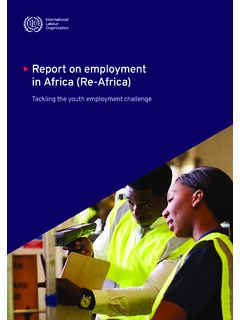Transcription of Motivation and barriers to learning for young people not ...
1 1 BIS RESEARCH PAPER NUMBER 87 Motivation and barriers to learning for young people not in education , employment or training FEBRUARY 2013 The views expressed in this report are the authors and do not necessarily reflect those of the Department for Business, Innovation and Skills. Department for Business, Innovation and Skills 1 Victoria Street London SW1H 0ET Research paper number 87 February 2013 2 Motivation and barriers to learning for young people who are not in education , employment or training Contents Contents .. 3 Introduction .. 6 The NEET national research project ..6 7 Key 8 Policy 10 Motivation to learn .. 11 To achieve future career 11 To gain employment or increase employability.
2 11 To gain qualifications .. 11 To develop skills, experience and 11 For personal development .. 11 By receiving professional support, information, advice and guidance (IAG).. 12 By receiving support from partners, family members and peers .. 12 For enjoyment and interest ..12 By a style of learning or learning environment .. 12 As a productive use of By financial support and 13 By previous or current learning 13 In order to widen options and increase 13 As an employer requirement .. 13 barriers to learning .. 14 Family, partner and peers ..14 3 Motivation and barriers to learning for young people who are not in education , employment or training Course content and Cost and finances .. 14 Behaviour, attendance or attitude.
3 15 Accessibility and availability of courses .. 15 Lack of professional support, information, advice and guidance (IAG) .. 15 Lack of skills or 15 Personal circumstances ..15 Health and disability .. 16 Lack of Motivation or direction ..16 Poor previous learning 16 Offers of employment without 16 young people with recent experience of being NEET .. 17 Who are they?.. 17 17 18 Implications .. 18 young people who have applied for a course .. 19 Who are they?.. 19 19 20 Implications .. 20 young people looking for learning opportunities .. 21 Who are they?.. 21 21 22 4 Motivation and barriers to learning for young people who are not in education , employment or training Implications .. 22 young people who want to learn in the future.
4 23 Who are they?.. 23 23 24 Implications .. 24 young people with no plans regarding learning .. 25 Who are they?.. 25 25 26 Implications .. 26 Conclusion .. 27 5 Motivation and barriers to learning for young people who are not in education , employment or training Introduction In recent years there has been an increase in the number of young people (aged 18-24) who are not in education , employment or training (NEET). For some young people , this will be a temporary setback, while for others it will have a long term detrimental effect on their future life chances. In order to ensure that effective interventions are developed and targeted appropriately, it is necessary to develop an understanding of who is not in education , employment or training , and the particular circumstances in which they find themselves.
5 In order to contribute to the development of this understanding, the Department for Business Innovation and Skills (BIS) commissioned the National Institute of Adult Continuing education (NIACE) to undertake an analysis of data collected from interviews with young people , aged 18-24, conducted as part of the NEET National Research Project. This helps build on the more extensive evidence base focussed on 16-18 year olds. The aim of this analysis was to develop a better understanding of the circumstances and motivations of young people who are not in education , employment or training (or have recently been in these circumstances) so that policies can be better targeted for this group within the funding available.
6 This summary report establishes a number of categories based on the barriers young people feel they face and the factors that would motivate them to engage in learning . The NEET national research project In early 2010, NIACE was invited by the learning and Skills Improvement Service (LSIS) to develop a national research project, involving colleges, other learning providers and outreach agencies to look at the attitudes and experiences of adults and young people who are currently, or have recent experience of being, not engaged in education , employment or training (NEET). The aims of the research project were to: improve understanding of the aspirations, Motivation and behaviours of young people and adults not in education , employment or training ; support providers in the learning and skills sector to secure institution-specific evidence to develop their understanding in relation to these issues; inform individual provider strategies to meet the needs of young people and adults in their locality; and inform the national strategy for raising the participation age.
7 NIACE was commissioned to achieve these aims by supporting providers to collate a range of research evidence from adults and young people who are not engaged in education , employment or training , as well as on effective practice in engaging with people 6 Motivation and barriers to learning for young people who are not in education , employment or training in these circumstances. In total, NIACE worked with 124 learning providers to collect interview data from over 2,000 adults and young people with current or recent experience of being not in education , employment or training1 2. For the purposes of this study NEETs were defined as young people (aged 16-24) or adults (aged 25+ years) who were not in employment , education (full-time, part-time, or on a gap year having an agreed HE start date) or government supported training .
8 This included: those undertaking voluntary work or personal development opportunities; those seeking (or waiting to start) work or learning ; those who were not active in the labour market (including those experiencing ill-health, caring for children, etc). Further information about the research can be found at: Methodology As part of the NEET national research project, 806 qualitative interviews were conducted with young people age 18-24 with current or recent experience of being not in education , employment or training . NIACE were commissioned to segment this sample of young people and to explore motivations and barriers to learning in relation to each group. While categorising and labelling young people is not a desirable process, identifying commonalities and differences in the motivations and barriers to learning of groups of individuals can be a useful strategy in enabling policy-makers and providers to identify and develop effective interventions in supporting young people back into education , training or employment .
9 Given the value to policy makers of previous segmented analyses of young people not in education , employment or training , particularly that first published by DCSF3, it was decided, in consultation with BIS, that a similar framework should be used in analysing the data from the NEET national research project. 1 young people were mainly identified by providers through their links with other agencies and organisations in their local area, such as Connexions, Job Centre Plus, youth clubs, housing associations, social services etc. Where young people were directly recruited by the learning provider, these tended to be prospective students, ex-students, or current learners on programmes such as Entry to employment (E2E).
10 Some providers were already delivering projects with young people who were NEET and chose to interview those young people with whom they were already working. This sampling process is likely to have skewed the sample towards those young people with a more positive attitude towards learning . 2 Interviews were undertaken by providers, resulting in a degree of inconsistency in how they were undertaken. 3 National Foundation for Educational Research (2009) Increasing Participation: Understanding young people Who Do Not Participate in education or training at 16 or 17. Nottingham: DCSF. 7 Motivation and barriers to learning for young people who are not in education , employment or training As the research project was not originally designed with this in mind, it was not possible to create an exact match between the available attributes of the young people interviewed and the segments within the DCSF typology.












